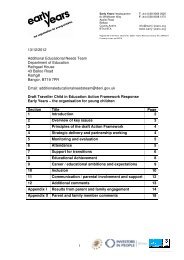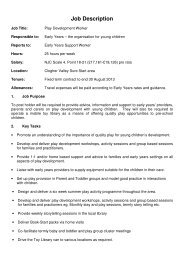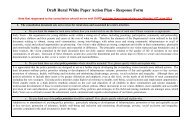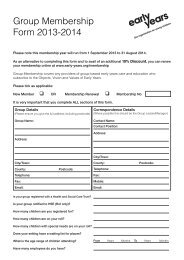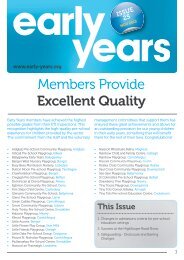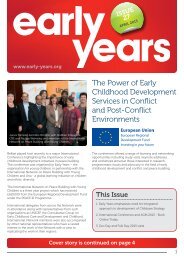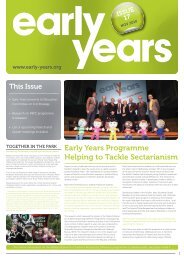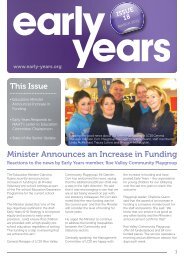Learning from Nine Examples of Peacebuilding Evaluation
Learning from Nine Examples of Peacebuilding Evaluation
Learning from Nine Examples of Peacebuilding Evaluation
Create successful ePaper yourself
Turn your PDF publications into a flip-book with our unique Google optimized e-Paper software.
<strong>Evaluation</strong> Strategy<br />
Pact and Act! decided that Action Research was an appropriate methodology<br />
for their purposes given that the reflective nature <strong>of</strong> the methodology<br />
took advantage <strong>of</strong> the strong oral tradition in the region and the social role<br />
external actors could play in asking potentially controversial questions. The<br />
strategy also allowed for the development <strong>of</strong> self-reflective skills among<br />
local leaders in another sphere. For the Pact and Act! team, these considerations<br />
meant developing a process in which peacebuilders examined their<br />
own theory and practices systematically and carefully.<br />
Three themes were focused on: collaborative peace system strengthening,<br />
sector response unit strengthening, and trauma healing and social reconciliation.<br />
In total, fifty-five action researchers were selected <strong>from</strong> Somali project<br />
partners based on at least five years <strong>of</strong> experience in peacebuilding, interest<br />
in participating, and English literacy. Participants underwent training for ten<br />
days, during which external facilitators also helped them develop specific<br />
research questions. For ongoing support, the Center for Peace and Action<br />
Research in Wajir, Kenya provided mentoring throughout the project.<br />
Considerations on the Methodology<br />
Strengths<br />
• The process <strong>of</strong> deep self-reflection allowed the research team to not only<br />
learn <strong>from</strong> the project but also test long-held assumptions about cultural<br />
attitudes, including whether or not one’s own culture was predominantly a<br />
culture <strong>of</strong> violence or a culture <strong>of</strong> peace. The process also created a safe<br />
space for local partners and the program implementers to step out <strong>of</strong> those<br />
culture norms for a moment. For instance, in the Somali cultural context, the<br />
research team discovered that expressing personal feelings is seen traditionally<br />
as betrayal <strong>of</strong> the wider community. In particular, women, who due to<br />
caste system norms in Somalia did not have a space to express their thoughts,<br />
now were able to express their feelings about their role in peacebuilding.<br />
41<br />
• The inclusion <strong>of</strong> the organizations’ internal teams has made them more reflective<br />
and see themselves as a part <strong>of</strong> the change needed to build stable<br />
peace. As a result, they are taking more direct initiative to address problems<br />
they have identified.<br />
Challenges and Pitfalls<br />
• The method was deeply rooted within the organizations’ structures. As a<br />
result, the methodology could not provide the objectivity that an external<br />
evaluator could.<br />
• As with most new procedures and processes, the staff needed to be made<br />
familiar with this methodology and also increase their ability to adopt a<br />
more objective research perspective given the nature <strong>of</strong> the oral cultures in



